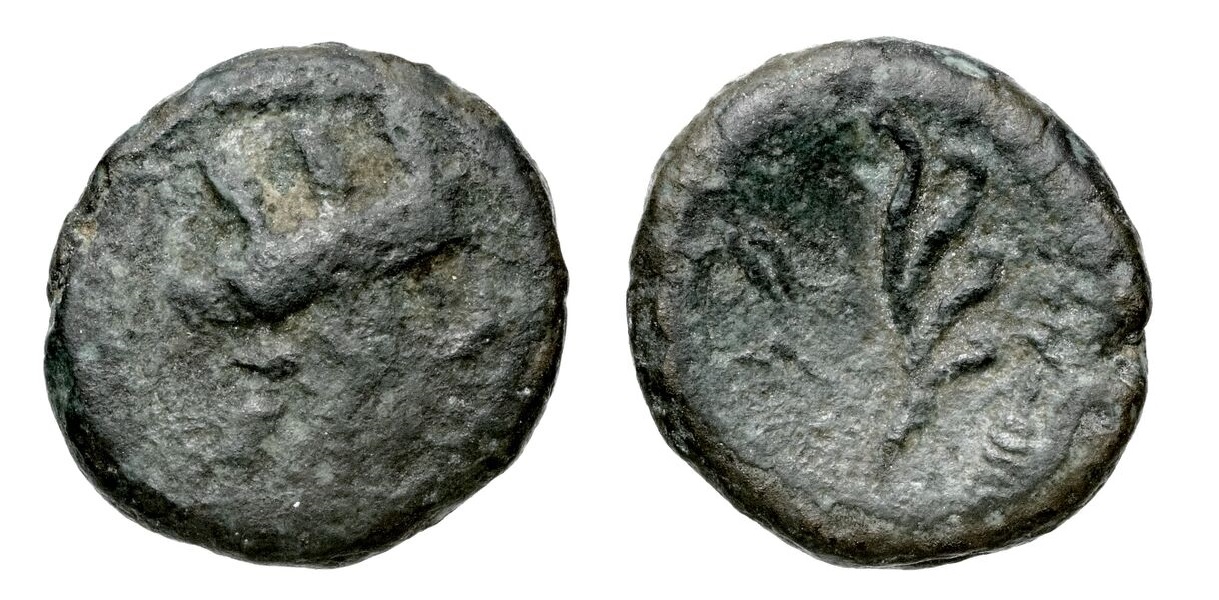S 60 - Aradus, bronze, NC, 174-9 BC
From SILVER
174 BCE - 9 BCE Bronze
Description
| ObverseInscription or printing placed on the obverse.: | Head of Tyche right |
| ReverseInscription or printing placed on the reverse.: | Aplustre |
Mint and issuing power
| MintIdentifies the place of manufacture or issue of a numismatic object.: | Aradus | Ancient regionAncient region.: | Syria (Phoenicia) | Modern countryModern country: Syria | AuthorityIdentifies the issuing power. The authority can be "pretended" when the name or the portrait of X is on the coin but he/she was not the issuing power. It can also be "uncertain" when there is no mention of X on the coin but he/she was the issuing power according to the historical sources: |
Chronology
| FromIdentifies the initial date in a range assigned in a numismatic context. | 174 BCE | toIdentifies the final date in a range assigned in a numismatic context.. | 9 BCE | PeriodTime period of the numismatic object.: Hellenistic 323-30 BC |
Physical description
| MetalThe physical material (usually metal) from which an object is made.: | Bronze |
Median weightMedian of the weights of numismatic objects (in grams). in grams | 1.55 | DenominationTerm indicating the value of a numismatic object. Examples: tetradrachm, chalkous, denarius.: | StandardStandard.: | ||
| Average weightAverage of the weights of numismatic objects (in grams).: | |||||||
| Mode weightMode of the weights of numismatic objects (in grams).: | 1,5-1,99<ul><li>No units of measurement were declared for this property.</li> <!--br--><li>",5-1,99" is not declared as a valid unit of measurement for this property.</li></ul> |
Image

S 60 - Aradus, bronze, NC, 174-9 BC.jpg [1]
References
| Die study referencePublication of the study: | Duyrat 20051Duyrat 2005, p. 71-72, no. 2495-2572 (series 8). | ||
| Coin series referenceReference to coin series study: | |||
Obverse dies distribution
| FrequencyFrequency of specimen in distribution. ᵖ | Number of obversesNumber of obverse dies. ᵖ (o) | % (o) | Number of coinsNumber of coins. (n) | % (n) | Die nameName(s) of the die(s). |
| 1 | 23 | 54.76 | 23 | 30.26 | 2, 5, 6, 7, 14, 16, 17, 19, 22, 24, 26, 27, 29, 30, 31, 32, 35, 36, 37, 38, 39, 40, 42 |
| 2 | 11 | 26.19 | 22 | 28.95 | 1, 3, 8, 9, 13, 15, 18, 20, 21, 34, 41 |
| 3 | 5 | 11.9 | 15 | 19.74 | 10, 12, 23, 25, 33 |
| 4 | 2 | 4.76 | 8 | 10.53 | 4, 11 |
| 8 | 1 | 2.38 | 8 | 10.53 | 28 |
| Total | 42 of 42 | 99.99 | 76 of 76 | 100.01 |
Reverse dies distribution
no distribution is available
Quantification
| Number of obversesNumber of obverse dies. ᵖ (o) | 42 | Number of singletons (o1)The number of singleton coins. ᵖ | 23 |
| Number of reverse diesNumber of reverse dies. (r) | 62 | Number of coinsNumber of coins. (n) | 76 |
| Coins per obverse dieNumber of coins per obverse die. (n/o) | 1.81 | Coins per reverse dieNumber of coins per reverse die. (n/r) | 1.23 |
| Reverse per obverse ratioRatio of obverse dies divided by reverse dies. (r/o) | 1.48 | Percentage of singletons (o1)number of coins (n) divided by the number of singletons (o1) ᵖ | 54.76 % |
| Original number of dies (O) (Carter 1983 formula)The estimation of the number of coins according to Carter 1983 ᵖ | 76.02 | Coins struck if 20,000 as average productivity per dieCoins made if the average productivity for obverses (according to Carter) is 20,000. ᵖ | 1,520,400 |
| Original number of dies (O) (Esty 2011 formula)The estimation of the number of coins according to the singleton formula in Esty 2011 ᵖ (O) | 93.88 | Survival rate if 20,000 as average productivity per dieSurvival rate if average productivity is 20,000. ᵖ | 0.00005 |
| Coverage (o = % of O) (Esty 1984 formula)Esty 1984 - coverage (% of O) ᵖ (o = % of O) | 69.74% | Die productivity if survival rate 1/2,000Average productivity if survival rate is 1/2,000. ᵖ | 1,999.47 |
| Weight of silver (in kg) if 20,000 coins per die (O = Carter formula)Carter 1983 * Median weight * 20000 (*10 if gold or electrum) ᵖ | n.a. | Die productivity if survival rate 1/5,000Average productivity if survival rate is 1/5,000. ᵖ | 4,998.68 |
Remarks
Most likely one single workstation